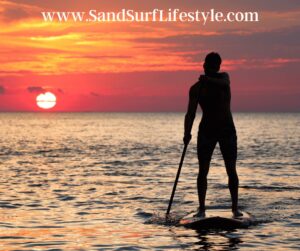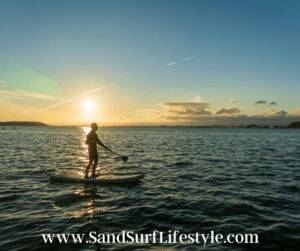What is the best time to paddleboard in the ocean?
Paddle boarding is a great time — or at least it is under the right conditions. As many watersport enthusiasts can tell you, factors like weather and the water’s behavior can easily make or break any experience that takes place at sea. Safe, lovely conditions increase your chances of having a wonderful day out on the water, whereas perilous, harsh ones can make you extremely miserable and put you off paddle boarding in the future. In other words, we are all at nature’s mercy — especially when it comes to the ocean. That’s why it’s so vital to know the best times to go paddle boarding even before hitting the water.
Certain times are better than others when it comes to paddle boarding in the ocean. For optimal safety and enjoyment, the best times to go paddle boarding are:
1) At slack tide (Slack tide occurs about an hour before or after both high and low tide.)
2) During minimal wind times
3) While the ocean is at warmer water temperatures (about 85 degrees Fahrenheit for beginners, between 80 and 85 degrees Fahrenheit for intermediates, and over 60 degrees for experts)
4) In the summertime.
 Any safe, successful paddle boarding experience requires not only the correct tide, wind speed, water temperatures, and weather, but also the correct paddleboard. If you don’t have the right one for your body size, skill level, or local ocean climate, you’ll quickly find that none of the advice here is particularly helpful. Even though this article is all about choosing the best times to go paddle boarding, we still feel it’s our responsibility to urge you to take the time to pick out a board that works for you instead of against you.
Any safe, successful paddle boarding experience requires not only the correct tide, wind speed, water temperatures, and weather, but also the correct paddleboard. If you don’t have the right one for your body size, skill level, or local ocean climate, you’ll quickly find that none of the advice here is particularly helpful. Even though this article is all about choosing the best times to go paddle boarding, we still feel it’s our responsibility to urge you to take the time to pick out a board that works for you instead of against you.
Tide
Tide is the up-and-down, side-to-side movement of the ocean — and one of the major determining factors when it comes to deciding when to go out on the water. The best time to go paddle boarding — especially for beginners with additional safety concerns — is during slack tide. Slack tide occurs about an hour before or after both high and low tide.
However, slack tide should not be conflated with mid tide. More often than not, mid tide is the most hazardous time to go paddle boarding. This particularly applies to beginners. Mid tide occurs during the period between high and low tide, which spans a little over 6 hours. Here, the currents range between extremes — very strong, and very weak — and should generally be avoided by paddleboarders.
In places where paddle boarding in low tide is possible, the no swell, low wind nature of it makes it ideal for beginners. However, while low tide is better than high tide for beginners looking to paddleboard, the viability of this option depends entirely on your location. In some places, low tide means there isn’t even any water to paddleboard in! Those living in areas where this occurs might, therefore, opt for high tide instead.
Regardless, entering and exiting the water during high tide can be extremely difficult and, therefore, dangerous. This makes high tide tricky for everyone — not just beginners. Therefore, paddleboarders who must [or else choose to] opt for high tide should always do so accompanied by a strong swimmer and with a safety plan already in place. Buoyancy devices also always come recommended.
Wind
 Even while out on the water, wind matters. Paddle boarding during minimal wind times comes highly recommended not only for beginners but for paddleboarders of all levels. While it is possible to paddleboard in higher winds once you’re more familiar with navigating your SUP, beginners will find this endeavor especially trying, dangerous, and exhausting.
Even while out on the water, wind matters. Paddle boarding during minimal wind times comes highly recommended not only for beginners but for paddleboarders of all levels. While it is possible to paddleboard in higher winds once you’re more familiar with navigating your SUP, beginners will find this endeavor especially trying, dangerous, and exhausting.
It’s always important to check the weather before going out on the water, mainly because you’ll want to avoid extreme heat, excessive cold, thunder, lightning, hail, heavy rains, and probably even fog in addition to harsh winds while paddle boarding. Nevertheless, the wind is fickle. This means that even while you’re already out on the water paddle boarding, the wind may very well change directions, pick up speed, and/or increase in force without warning. This will also change the behavior of the water, making it colder and more turbulent.
Always remember that in the event this happens, you’re free to exit the water, head to land, and either retreat or else try to wait out the wind for a while. In fact, we strongly recommend doing exactly this. For those more advanced paddleboarders who prefer high-wind paddle boarding, we simply suggest that you always keep safety in mind. Aquatic escapades are only as fun as they are safe. Unfortunately, the sea plays by its own rules — not ours.
Can you use a paddleboard to surf? Find out here.
Water Temperatures
Optimal water temperatures for paddle boarding may vary from person to person. However, there are general temperatures (give or take a few degrees) paddleboarders should aim for, or else avoid. Moreover, keep in mind that wind can make the water feel much cooler, whereas the sun can make it feel much warmer. In the right amounts, temperature interference by the wind or sun can be a relief — but in excess, paddleboarders who attempt to endure these conditions put themselves at risk for overexposure, dehydration, heatstroke, cold shock, and death.
Ideally, 85 degrees Fahrenheit or higher is the best time to go paddle boarding for beginners, and the most enjoyable for more seasoned paddleboarders looking for a calm day out at sea. At 85 degrees, the water allows you to relax while serenely navigating the ins, outs, challenges, and thrills of paddle boarding.
Some intermediate paddleboarders prefer water at about 80 degrees Fahrenheit, whereas many expert paddleboarders opt for the 60 to low 80 degrees Fahrenheit range instead. These temperatures are cool enough that standing on your paddleboard probably won’t result in you baking in the sun. Simultaneously, water temperatures in this range are still generally warm enough that falling into the ocean shouldn’t put your life at risk — other potential, hazardous conditions aside.
Seasons
 Depending on where you are on the globe, you may find that certain seasons are better for paddle boarding than others. Summer is generally optimal, whereas winter generally is not. Of course, summer days can also get too hot — meaning it’s important to know your limits and how much heat you can actually tolerate.
Depending on where you are on the globe, you may find that certain seasons are better for paddle boarding than others. Summer is generally optimal, whereas winter generally is not. Of course, summer days can also get too hot — meaning it’s important to know your limits and how much heat you can actually tolerate.
Monsoons, especially during the actual rains themselves, are usually not ideal. There may be some days where the conditions are viable or even made better by the abundant rains, but paddle boarding under heavy monsoon rains is normally not advised. Not only do they affect the behavior of the ocean, making it more unstable, but paddle boarding under them puts you at risk of cold, overexposure, and death. Similar things can also be said for hurricane seasons.
Transitional seasons, like spring and autumn, can be trickier to navigate. While beachy areas often have delightful conditions during these times of the year, spring and autumn do sometimes bring with them a vast range of weather that can make daily paddle boarding difficult and unsafe. For these times of the year, we recommend using your judgment based on the tide, wind, weather, and of course, the water temperature.
Related Questions
1. What if I’m a beginner at paddle boarding, but live in an area where I can’t go out during low tide? Will I really be okay paddle boarding in high tide?
Having to opt for the high tide can be tough on beginners, especially in areas where paddle boarding in low tide isn’t possible. Take people with you who can swim, and secure your buoyancy device even before going out on the water. If you take these precautions, paddle boarding in high tide should be safe enough — any other prospective, dangerous conditions aside.
2. What happens if I go paddle boarding in water temperatures below 60 degrees Fahrenheit?
Truthfully, and especially without the correct gear, you run the risk of experiencing overexposure from cold water temperatures, going into shock, and/or suffering from other conditions that may result in death. It’ll also be tougher to navigate yourself and your paddleboard through the water. Warmer water temperatures of 60 degrees Fahrenheit and up are ideal for these reasons.

Please note: This blog post is for educational purposes only and does not constitute legal or medical advice. Please consult a legal expert or medical professional to address your specific needs.

